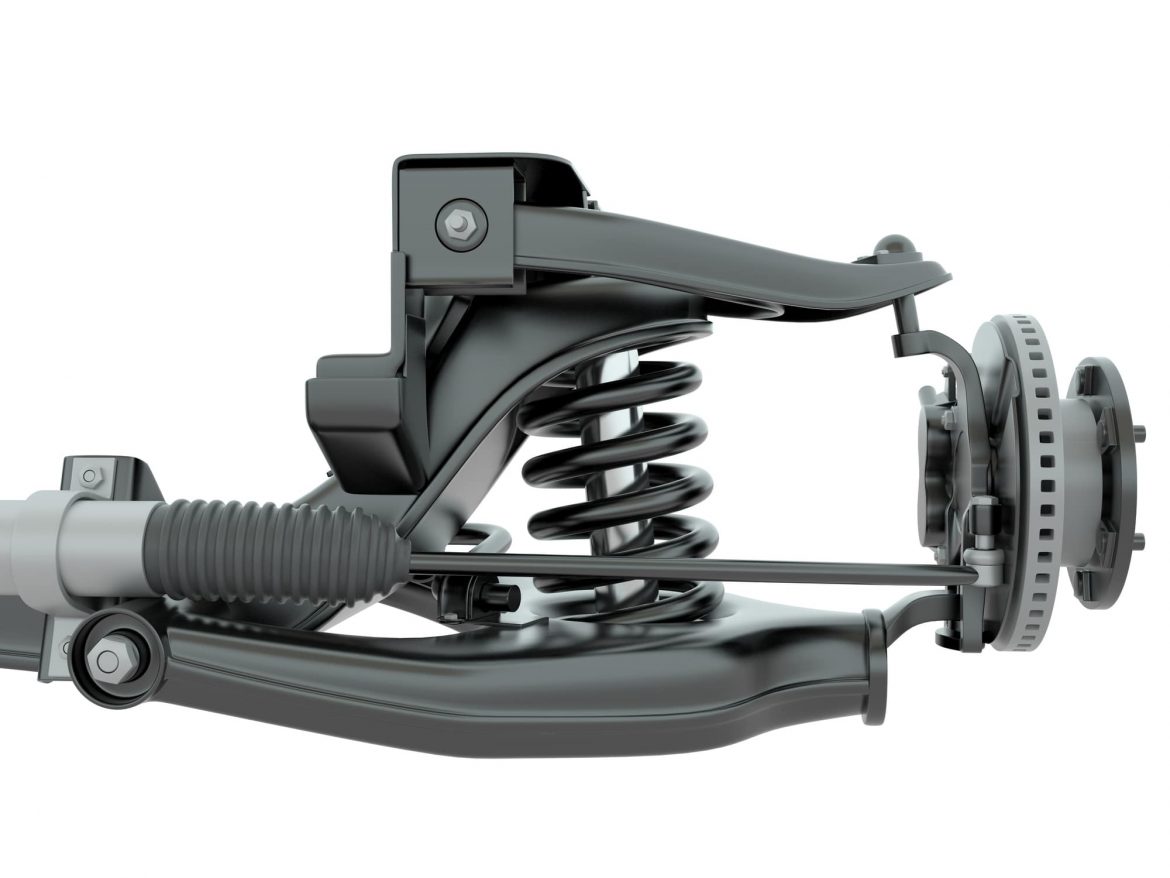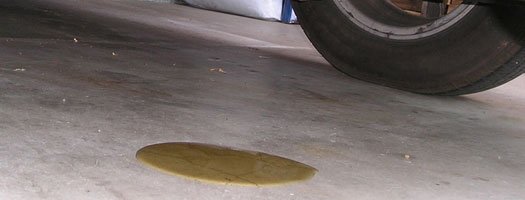Oh man, are you in trouble? Your car or truck is leaking oil, and that can be a really bad sign. Left unchecked, it can destroy the vehicle’s engine, cost you thousands of dollars and leave you without transportation. Even in the best case scenario, you’re pouring new oil—and money—down the crank case periodically, and either drizzling oil on the road, leaving spots in your driveway or blowing it out your exhaust pipe. Regardless, you’re not being very kind to the environment.
Bottom line: You need to do something about the oil leak in your car or truck.
Stopping an oil leak ranges from simple to complicated and from a couple of bucks to $1,000. Before repairing the leak it is important to understand motor oil’s critical purpose in the engine and the various sources of an oil leak.
How Oil Works in a Car
Oil is a lubricant, specifically formulated to withstand a temperature range from below zero to above 200 degrees Fahrenheit while cycling through a vehicle’s engine. Motor oil is fed into the engine’s mechanical parts to protect metal parts that move constantly, like pistons that pump up and down rapidly inside metal cylinders. Oil forms a barrier between the metal piston and the metal cylinder to prevent wear, ensure smooth motion and keep metal from burning up.
As it circulates around the combustion chamber towards the oil filter for its regular cleaning, oil offers a helping hand to the antifreeze-water combination working hard to cool the parts of the engine that are literally on fire. Oil circulates many thousands of times during its 3,000 miles or more of life inside the vehicle.
Oil does not work as well when it is draining out of the system via a hole, crack or bad fitting seal. Even worse, when oil seeps into the combustion chamber, where fire needs to ignite fuel and air to power the vehicle, the presence of oil can interfere with the process. Oil on a spark plug can prevent sparking. Oil in the coolant can reduce its cooling capacity and clog up the system.
In other words, oil is critically important where it is needed and a terrible disrupter where it doesn’t belong.
What Causes an Oil Leak in a Car and How Do I Stop It?
There are a handful of reasons oil is leaking either under the hood or outside the vehicle. Here are some of the common causes of an oil leak and how to fix each one:
1. The oil filter was installed incorrectly.
The best-case scenario in the world of oil leaks is that the oil filter was improperly attached. Either it was screwed on too tight, which can mash the top of the filter and prevent a good fit, or it was not tightened sufficiently. Oil filters sometimes screw on a little off-kilter and fail to make a tight seal. Any of these can cause a leak.
The fix: Oil filter leaks are easily repaired by loosening or tightening the filter, or re-attaching it. If it is being removed, the oil must first be drained or you could end up wearing several quarts of motor oil and adding a new shirt to the cost of the repair.
Remember that an oil filter is loosened with a filter wrench but tightened only by hand. Using a wrench will cause over-tightening and risk a new leak.
A common mistake made by DIYers involves the oil filter gasket. After 3,000 or more miles that prompt an oil change, the gasket can get stuck to the engine even as the filter is removed. Attaching a new oil filter, with its own gasket (or o-ring) on top of the original gasket, prevents the filter from fitting tightly and creates an avenue of escape for oil.
The fix: The good news about this issue is that it is simple to repair. Drain the oil, as you would do for an oil change, recapturing it in a drain pan, and correct the filter issue. Then pour the oil back into the crank case and add however much is needed.
2. The drain plug was tightened wrong.
This is another good case scenario. The drain pan and plug hang beneath the vehicle and invite attacks by roadway debris like rocks, gravel, dirt and whatever can fall off the back of a truck. Eventually, the wear and tear can punch a hole in the plug or pan, corrode them or otherwise reduce their structural integrity.
The fix: This is an easy problem to spot and fix, simply by replacing the plug or pan. A new drain plug is a couple of bucks and a whole new pan varies but generally costs below triple digits.
The plug can also be over- or under-tightened. The latter is a simple matter of tightening it further. Putting too much torque on the plug can break it or the nipple onto which it attaches. Again, that might mean a new plug or drain pan. As with the oil filter, removing the pan requires first draining the oil.
3. There is a problem with a gasket, seal or o-ring.
This is a broad category of problems that have the following in common: a transition point in the engine where two parts meet and are sealed by a gasket, o-ring or valve seal is not airtight. There are many such points in an automobile, such as the rocker cover gasket, the front-end timing cover gasket, the front main seal, the head gasket, the dipstick tube o-ring and more.
With most of these seal leaks, oil will spill and build up on engine parts, Left to its own devices, the oil will grease other parts of the engine and interfere with the combustion process. This will present itself, eventually, in lost gas mileage and inefficient operation.
These leaky seals are easy to fix, simply by replacing the gasket, o-ring or valve seal, usually a rubber part costing a few dollars. Unfortunately, some of them are more difficult to access than others and can make repair a costly and time-consuming nightmare.
An example of this is the head gasket, which is actually a more complex metal sandwich that separates the engine block from cylinder head. Its job is specifically to keep oil from spilling into the chamber where explosions occur and to keep fuel and sparks from destroying the moving parts. Though easy to replace, accessing this $20-$50 gasket requires the disassembly of many engine parts and generally costs over $1,000 at a service station.
The fix: If the problem is a small leak in a hose, pan or seal, an easy, inexpensive and permanent solution is a sealant, like BlueDevil Oil Stop Leak. Poured into the crank case, a $20 bottle of BlueDevil Oil Stop Leak fills the crevices and keeps the oil where it belongs for the life of the car, guaranteed. When using this product, the engine must be allowed to run for an hour or two so the solution can circulate completely through the vehicle.
4. The rear main seal is leaking.
If oil is emanating from the back of the engine, that is a sign of a leaky rear main seal. It is bad news and should be addressed immediately.
The rear main seal keeps oil inside the rear of the engine where the transmission connects to the crankshaft. Because of the oil pressure at that point, even a small leak is liable to grow quickly. Also, the leaking oil tends to collect on the underside of the vehicle, creating a mess that is difficult to clean and risking a fire hazard if the oil gets into the exhaust system. In other words, don’t let a rear main seal leak go for long.
The fix: Accessing the rear main seal requires removal of the transmission—and sometimes other parts of the engine—driving up the cost to the $600-$1,000 range, though the seal itself is merely a rubber or silicone ring priced at a few bucks. Some mechanics won’t consider repairing a rear main seal without removing the motor and at least partially rebuilding the engine.
When the hard repair part isn’t an option, a chemical solution like BlueDevil Rear Main Sealer is guaranteed to seal the leak permanently in gas or diesel engines. Simply pour the bottle into the engine oil while the vehicle is turned off and start the engine. It may take 1-2 days of driving for the leaks to seal.
BlueDevil Products can be found at AutoZone, Advance Auto Parts, O’Reilly Auto Parts, NAPA, Parts Authority, and online through Amazon
BlueDevil Products can be found on Amazon.com or at AutoZone, Advance Auto Parts, O’Reilly Auto Parts, NAPA, and other major auto parts retailers.
10 responses to "How to Stop an Oil Leak in Your Car"
10 Comments
Leave a Reply
Related Articles




I have a 2016 Toyota Tacoma Double Cab SRD. The dealership did an oil change in March 2021 and said I have an oil leak but did not where it was coming from. So they added trace die. I went back in and said it was a very slow oil leak but it is coming from the timing cover and needs to be resealed. Mind you they had to use a UV light to see where it was leaking from as there is no oil leaking on the ground and my oil levels are normal. They quoted me $4,100 to fix. Will BlueDevil Oil Stop Leak work this issue? Thank you I’m advance.
Amber-
Thank you for asking about your Toyota Tacoma. Based on your description, you would be a great candidate for the BlueDevil Oil Stop Leak. The product would work on a leaking timing cover gasket. You should expect to start seeing results after 100-200 miles of driving.
Thank you!
-BDP
Hi there. I have a question. I recently used your engine oil leak stop. I had a ever so slight leak, off the gasket in a 2001 Ford Escape V6. Put in your product and the leak completely stopped after about 300 kms, here in Canada.
Now my question is..If I use an engine flush like Seafoam, which I use quite a bit, with that remove the sealant that your product created on that gasket ?? Because I sure don’t want to do that ..thanks
Warren-
We’re glad to hear that the product was able to seal the leak on your Ford Escape! It would be fine to flush the engine with SeaFoam at this point. It would not undo the seal the product has already created. Thank you for sharing!
Thank you!
-BDP
I have an oil leak I believe. Would your product work for a 2006 Hyundai Sonata 3.3 v6?
A’Kira-
Yes, the BlueDevil Oil Stop Leak is safe and compatible to use on your Hyundai Sonata. Feel free to contact our technical support line at 888-863-0426 with any other questions.
Thank you!
-BDP
Hi I have a small oil leak from the rear of my engine I am told by my garage but it would cost more than the car is worth to rectify, as the engine would Neto be removed am told, will this product help
Lynn-
Based on your description, we’d recommend using the BlueDevil Rear Main Sealer. The product is intended for leaks that are seeping or lightly dripping. You should expect to start seeing results after 100-200 miles of driving.
Thank you!
-BDP
Hi I have a 2015 ferrari california t with a minor oil leak from head gasket. Would any of your product work for my car? Thank you so much
Justin-
Unfortunately, we don’t manufacture a product intended to stop oil from leaking from the head gasket. Our BlueDevil Head Gasket Sealer is specifically intended for water/coolant leaks. Replacing the head gasket may be your best option.
Thank you!
-BDP